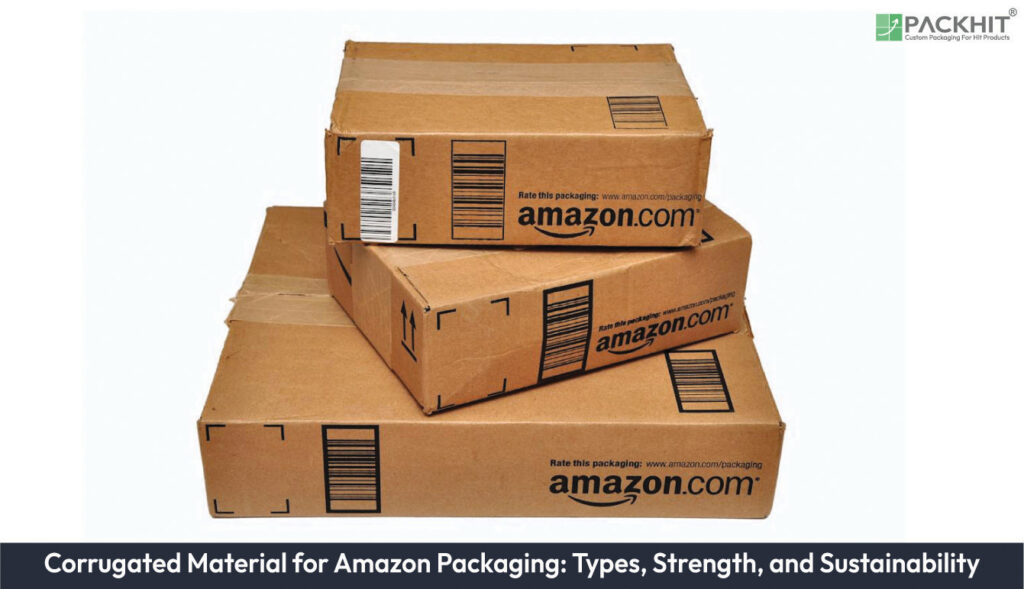Corrugated material is the foundation of Amazon’s packaging system, balancing durability, cost-efficiency, and environmental sustainability. It encompasses three primary types, including single-wall, double-wall, and triple-wall boards, each tailored for specific product categories based on strength and structural configurations. For lightweight items like books and apparel, single-wall boards offer protection with customizable flute profiles. Double-wall boards cater to heavier or delicate products with enhanced compression strength and puncture resistance, while triple-wall boards handle industrial shipments requiring maximum robustness. The strength of corrugated material is measured through tests such as Edge Crush Test (ECT), Burst Strength, and Box Compression Test (BCT), ensuring reliable performance under mechanical stresses. Sustainability remains integral, with corrugated material being recyclable, biodegradable, and designed for reduced waste.
What is Corrugated Material for Amazon Packaging?
Corrugated material is a type of packaging material composed of fluted paper sandwiched between flat linerboards, designed to provide durability, lightweight construction, and cost-efficiency. Amazon utilizes this material extensively in its packaging processes due to its adaptability across diverse product categories, from fragile items to bulk shipments, while supporting sustainability goals through recyclability and reduced waste.
What are the Types of Corrugated Material Used in Amazon Packaging?
Corrugated material is categorized based on its flute profile, wall construction, and paper grade for Amazon packaging. Amazon primarily employs three types of corrugated board: single-wall, double-wall, and triple-wall. Each type is tailored to specific packaging needs, balancing strength, weight, and cost considerations.
The three types of corrugated material used in Amazon packaging are mentioned below:
Single-Wall Corrugated Board
Single-wall corrugated board consists of one layer of fluted paper sandwiched between two flat linerboards. It is the most commonly used type for lightweight products, offering adequate protection for items such as books, apparel, and small electronics. Flute profiles in single-wall boards range from A-flute (thicker, better cushioning) to E-flute (thinner, better printability), allowing customization based on product fragility and branding requirements.
Double-Wall Corrugated Board
Double-wall corrugated board incorporates two layers of fluted paper and three linerboards, significantly enhancing its compression strength and puncture resistance. This type is ideal for heavier or more delicate items, such as kitchen appliances or bulk goods, where additional structural integrity is required. The combination of different flute sizes within the layers can optimize both cushioning and stacking strength.
Triple-Wall Corrugated Board
Triple-wall corrugated board, the most robust option, features three layers of fluted paper and four linerboards. It is used for industrial applications and heavy-duty shipping, such as transporting machinery or large quantities of liquid containers. While less common in Amazon’s consumer-facing packaging, it plays a critical role in their supply chain for bulk distribution.
How is the Strength of Corrugated Material Measured for Amazon Packaging?
The strength of corrugated material for Amazon packaging is quantified through standardized tests that evaluate its performance under various mechanical stresses. Key metrics include the Edge Crush Test (ECT), Burst Strength, and Box Compression Test (BCT), each providing insights into the material’s load-bearing capacity and durability.
Edge Crush Test (ECT)
The Edge Crush Test (ECT) measures the vertical compression strength of corrugated board, expressed in pounds per inch (lb/in). Higher ECT values indicate greater stacking strength, making it a critical parameter for Amazon’s packaging, where boxes are often stacked during storage and transit. For example, a 32 ECT board can withstand approximately 32 pounds of force per inch of edge.
Burst Strength
Burst strength evaluates the material’s resistance to puncture or rupture under pressure, measured in pounds per square inch (psi). This metric is particularly relevant for packaging fragile items, as it reflects the board’s ability to withstand sudden impacts or rough handling.
Box Compression Test (BCT)
The Box Compression Test (BCT) assesses the maximum load a corrugated box can endure before collapsing. It is calculated using the formula: BCT = k × √(ECT × thickness), where “k” is a constant derived from box dimensions. This test is essential for determining the suitability of corrugated material for high-stress shipping environments.
How Does Corrugated Material Align with Sustainability Goals for Amazon Packaging?
Corrugated material is inherently sustainable due to its recyclability, biodegradability, and renewable raw materials. Amazon’s commitment to reducing its environmental footprint has driven innovations in corrugated packaging, focusing on material efficiency, waste reduction, and circular economy principles.
Recyclability and Biodegradability
Corrugated board is composed primarily of cellulose fibers derived from trees, making it both recyclable and biodegradable. According to industry data, over 90% of corrugated packaging in the U.S. is recovered for recycling, and the recycled fibers are often used to produce new corrugated products, reducing the demand for virgin materials.
Lightweight Design
Advancements in corrugated material design have enabled the production of lighter yet stronger boards, minimizing material usage without compromising performance. This reduces the carbon footprint associated with raw material extraction, manufacturing, and transportation.
Amazon’s Frustration-Free Packaging Initiative
Amazon’s Frustration-Free Packaging program emphasizes the use of recyclable, easy-to-open corrugated boxes that eliminate the need for additional packaging materials. This initiative not only enhances customer satisfaction but also aligns with sustainability by reducing waste and improving recyclability.

